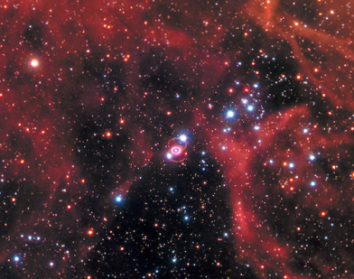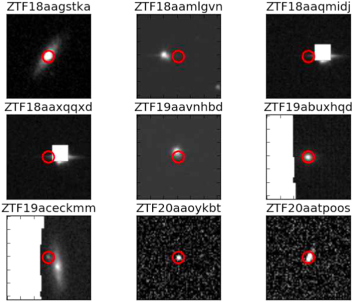
An image of the nearest supernova explosion seen in modern times, SN 1987A. Credit: NASA, ESA, R. Kirshner (Harvard-Smithsonian Center for Astrophysics and Gordon and Betty Moore Foundation), and M. Mutchler and R. Avila (STScI).
23 May 2023
In the search for supernovae, astronomers must comb through a wealth of data. Automated photometric surveys find millions of possible supernovae every night. This is far too many for astronomers to manually review each one and identify which may merit additional observation.
New research published in The Astrophysical Journal identified two new supernovae from hundreds of possibilities present in two independent projects’ overlapping survey regions. A team led by József Vinkó, research advisor at Konkoly Observatory, Hungary, used data from the Zwicky Transient Facility (ZTF) photometric survey to identify possible supernovae. They then reviewed data from the University of Texas at Austin’s Hobby-Eberly Telescope Dark Energy eXperiment (HETDEX) spectrographic survey to confirm which of these possible supernovae were the real deal.
While there was nothing particularly remarkable about the supernovae themselves, the circumstances of their classification are exciting: this marks a rare instance when a spectrographic survey has been used to identify a supernova and may point to a more efficient process for doing so in the future.
About Photometric and Spectroscopic Surveys
Each night, astronomical instruments survey our sky, documenting all manner of celestial objects for analysis.
Photometric surveys measure the intensity of light that these objects emit. They can help astronomers identify changes in brightness over time, which can indicate a star’s behavior, the presence of a supernova, the existence of extrasolar planets, and more.
Spectroscopic surveys document (as spectra) the electromagnetic radiation – X-ray, ultraviolet, visible light, etc. – that objects emit. Astronomers analyze spectra to identify the composition, density, temperature, and other properties associated with its source.
The Search for Supernovae: Detecting Flashes on an Industrial Scale
When a distant, massive star explodes as a supernova, the only sign of the monstrous violence seen from Earth is a tiny, modest flash in the night sky. Observations of these brief and easy-to-miss eruptions used to be pretty rare: astronomers would have to patiently and manually check the same patch of sky over and over again, hoping that in one of their images they’d see a bright speck of light that wasn’t there before.
But no more. With the advent of robotic telescopes, advanced imagers, and sophisticated software, this tedious process has been supplanted by a much more effective workflow. Large photometric surveys, such as ZTF, image huge swaths of the sky every night and automate the flash-detection process.
While astronomers previously treasured each flash, or “transient,” as a unique discovery, thanks to these automated surveys, they can now examine any number of the million or so detected each night.
And yet, even as these surveys churn out transients on an industrial scale, astronomers usually want to know more about each one than the fact that they exist. For example, is the source of the transient a supernova, a pulsating star, or something else? Historically, they’ve answered this question by recording not just images, but also spectra of each object.
Unfortunately, although spectroscopic surveys have also grown immensely more efficient, they have not kept pace with their photometric counterparts. This means that most transients discovered by ZTF will never have their spectra documented.
When Telescopes Align
Using HETDEX data, Vinkó’s team successfully added spectra to hundreds of transients discovered by ZTF. From 2018 to 2022, HETDEX was documenting spectra of high-redshift galaxies in one corner of the sky while ZTF was snapping images of the whole northern hemisphere with its camera.
By comparing ZTF’s alerts with logs of where HETDEX was pointing each night, the team found that 538 transients went off in the exact same area that the two survey projects were observing. Even more fortuitously, nine of these transients were still glowing when HETDEX took its measurements.
Using the HETDEX spectra, Vinkó and collaborators successfully identified two supernovae and classified hundreds of other transients as either active galactic nuclei or other known astronomical objects.
As more industrial-style surveys come on line in the coming decade, we can look forward to more of these discoveries in the near future.
- END -
Based on an article published on American Astronomical Society NOVA.

An image of the nearest supernova explosion seen in modern times, SN 1987A. Credit: NASA, ESA, R. Kirshner (Harvard-Smithsonian Center for Astrophysics and Gordon and Betty Moore Foundation), and M. Mutchler and R. Avila (STScI).

Cutout images of the nine transients that were “active” according to ZTF when HETDEX happened to observe them. Credit: Vinkó et al. 2023.